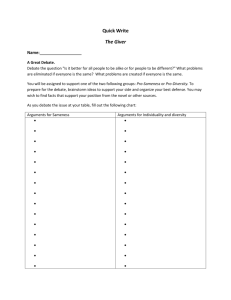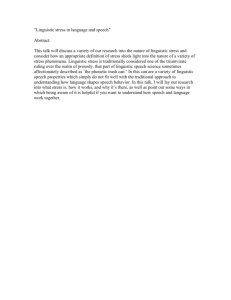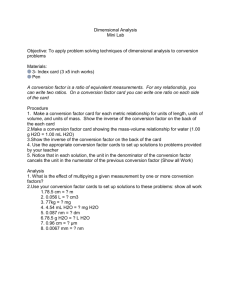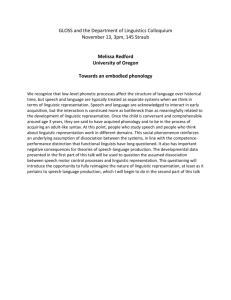Putnam`s ostensive definition of semantics for natural kind terms is
advertisement
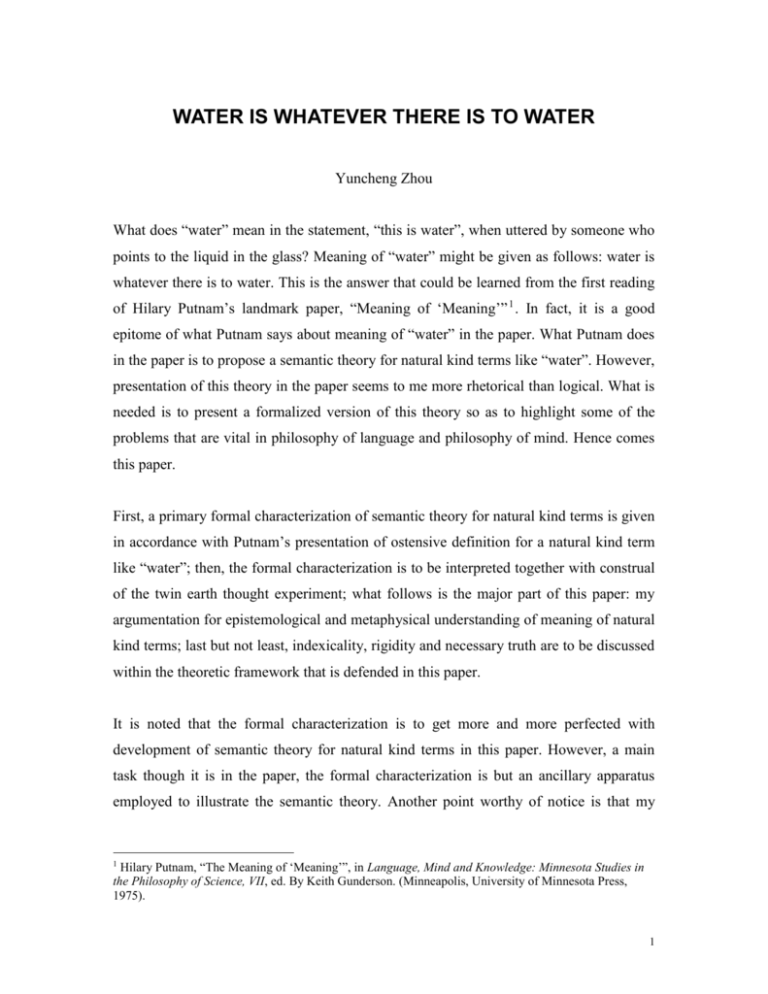
WATER IS WHATEVER THERE IS TO WATER Yuncheng Zhou What does “water” mean in the statement, “this is water”, when uttered by someone who points to the liquid in the glass? Meaning of “water” might be given as follows: water is whatever there is to water. This is the answer that could be learned from the first reading of Hilary Putnam’s landmark paper, “Meaning of ‘Meaning’” 1 . In fact, it is a good epitome of what Putnam says about meaning of “water” in the paper. What Putnam does in the paper is to propose a semantic theory for natural kind terms like “water”. However, presentation of this theory in the paper seems to me more rhetorical than logical. What is needed is to present a formalized version of this theory so as to highlight some of the problems that are vital in philosophy of language and philosophy of mind. Hence comes this paper. First, a primary formal characterization of semantic theory for natural kind terms is given in accordance with Putnam’s presentation of ostensive definition for a natural kind term like “water”; then, the formal characterization is to be interpreted together with construal of the twin earth thought experiment; what follows is the major part of this paper: my argumentation for epistemological and metaphysical understanding of meaning of natural kind terms; last but not least, indexicality, rigidity and necessary truth are to be discussed within the theoretic framework that is defended in this paper. It is noted that the formal characterization is to get more and more perfected with development of semantic theory for natural kind terms in this paper. However, a main task though it is in the paper, the formal characterization is but an ancillary apparatus employed to illustrate the semantic theory. Another point worthy of notice is that my Hilary Putnam, “The Meaning of ‘Meaning’”, in Language, Mind and Knowledge: Minnesota Studies in the Philosophy of Science, VII, ed. By Keith Gunderson. (Minneapolis, University of Minnesota Press, 1975). 1 1 argumentation for the semantic theory is much indebted to Kripke’s clarification of necessity in epistemological and metaphysical senses2. Primary Formal Characterization of Putnam’s Semantics for Natural Kind Terms Putnam’s ostensive definition of semantics for natural kind terms is something like this. Suppose someone points to a glass, and says, “There’s water in it.” Let’s assume that this utterance is transparently known to all the participants in the conversation. The semantic construction of this utterance is fully understandable to the participants. How could meaning of “water” in the utterance be understood? It is grounded on an empirical presupposition: The stuff in the glass has sameness relation to whatever is usually called “water” by the participants in the linguistic community. The idea could be represented as: (1) S (a, x), where “S” is sameness relation, a is the stuff in the glass, x is any stuff that could be called “water” in the linguistic community. We may further define x as y(y is A, B, C, … & x = y) where A, B, C, … are local stuffs being referred to as “water” in the linguistic community3. Just as Putnam says, the key point is how to construe “sameness relation”. Putnam holds that meaning of “water” is unsusceptible to any conceptual change that takes place over times and/or locations. In 1750, people called XYZ “water”, while in 1850 people would not call XYZ “water”, instead they called H2O “water”. Whatever is called “water”, meaning of “water” has remained the same all along. “Water” is whatever is in the glass, XYZ, H2O or anything else as long as “water” more than any others is being talked about. 2 See his Naming and Necessity (Cambridge, Harvard University Press 1980) In this paper, terms are symbolized as letters with quotation marks, e.g., “x”, and stuffs are represented as bold letters, e.g., x. 3 2 What relation is there between the stuff in the glass and XYZ/H2O? Sameness relation. Both the stuff in the glass and XYZ/H2O could be characterized by what water is. General representation is that a and x are both characterized by whatever water is. In other words, a and x share some properties that could constitute necessary and sufficient conditions for determining what water is. As is the case, that x is defined as y(y is A, B, C, … & x = y) makes it adequate to determine what water is that x is called water. However the fact that x is called water is a contingent fact. I.e., it is possible that x be called water and it is equally possible that x not be called water. The fact that x is water does not make a necessary condition for a to be nothing but water although it could provide a sufficient condition. How do we derive essential properties that could make it true that it is necessary for “a” to be water? There exists, among others, sameness relation—water is whatever there is to water. Meaning of water could be determined by one-place predicate (2) W(x) where “W” is defined as “… is water” and x is the same as it is in (1). What assignment of x could make the predicate apply to what “x” denotes4? Suppose x is assigned a value “table” as understood among English users of it, the predicate is not acceptable in this linguistic community. However “H2O” is a good assignment of x. What difference is there between “table” and “H2O” in terms of application of the predicate? Following Field’s interpretation of Tarski’s truth theory, we maintain that W(x) is true relative to a sequence if and only if there is a stuff A that “x” denotes and W(x) applies to A. For “x” to denote A relative to a sequence, it is defined that “xk” denotes the kth member of the sequence and A is the kth member of the sequence. “H2O” is the kth member of the sequence while “table” does not stand in this sequence. So what we need to do is to define a rule for the sequence—membership of sequence. The sequence is, in fact, y(y is A, B, C, …). “Table” is excluded from the sequence because it does not “denotes” is used here not as a semantic notion, but as Field’s semantic primitives. It could be replaced by “is”. See Hartry Field, “Tarski’s Theory of Truth”, in The Journal of Philosophy, Vol. LXIX, No. 13, July 13, 1972. 4 3 have membership required. Accordingly, a in (1) has to obtain the membership of y(y is A, B, C, …), otherwise the sameness relation would be unfounded. It can be concluded that the necessary condition for application of (1) is for a to obtain membership of y(y is A, B, C, …), represented as, y(y is A, B, C, a, …), whereas the sufficient condition is satisfied by definition of x, symbolized as, y(y is A, B, C, a, … & x = y). Generalized this way, semantics for natural kind terms proposed by Putnam has been demonstratively shown: (3) S (a, x) applies to what “a” and “x” denote iff y(y is A, B, C, a, … & x = y), where “S” stands for sameness relation, a is the paradigmatic stuff to be given semantic construction, A, B, C, … are local stuffs referred to in a linguistic community. Any specific semantic construction for a natural kind term could be generated from this general form. For instance, for “a” to be “water”, A, B, C,… are to be local stuffs in a linguistic community that are supposed to be called “water” whereby x could be characterized by whatever water is. In this course, meaning of “water” is given. Similarly any natural kind term could be given such a semantic interpretation. Interpretation of the Formal Characterization Putnam summarizes two assumptions of traditional semantic theory as follows: (i) grasping the concept in the mind that associates with a term makes necessary and sufficient conditions for determination of meaning of the term; (ii) Meaning of a term determines its reference. 5 The first assumption is concerned with meaning and mind while the second is about meaning and world. It is obvious that the two assumptions are not consistent with each other: meaning is either internal to mind or external to it. Putnam argues that the first assumption is false. He uses twin earth thought experiment to show 5 “The Meaning of ‘Meaning’”. Op. Cit. p. 135-136 4 that it is something external to mind 6 that could constitute necessary and sufficient conditions for determination of meaning of a term. Putnam’s twin earth thought experiment goes like this. Let’s imagine a twin earth that is similar to the earth except that water on twin earth is XYZ different from H2O on the earth. We assume that “water” is identically tokened as an utterance both on the earth and on the twin earth. Bert is a speaker on the earth, who says, “There’s water in the glass.” He has a doppelganger on the twin earth, who also says, “There’s water in the glass.” It is obvious that Bert and his doppelganger refer to different things although the token sentences they speak are the same. Putnam even tells us that Bert and his doppelganger are in identical psychological state but being in the same psychological state does not necessarily entail the sameness of the meaning of “water”. Then how could meaning of “water” be identified in a linguistic community if it does not supervene on psychological state of users of “water”? Putnam thereby puts forward his semantic theory in terms of semantics for natural kind terms. As is analyzed above, semantics for natural kind terms in Putnam’s theoretic framework is formally characterized as (3). Meaning of “water” is conditioned on sameness relation between what “a” denotes and what “x” denotes. Necessary and sufficient conditions for application of sameness relation is y(y is A, B, C, a, … & x = y). Meaning of the term “a”, say, a glass of water, is determined by what is essential to all the local stuffs including the paradigmatic stuff represented by a—characterization of what water is. Or in Donnellan’s words, “… (that) the extension of the term is determined by the underlying nature of some set of paradigms…” 7 This characterization of meaning circumvents the question of what underlying nature is. Instead it indicates where the underlying nature lies, leaving explication of underlying nature for empirical investigation. After all, it is a theoretical account of what meaning is. “The Meaning of ‘Meaning’”. Op. Cit. p.145. Putnam says: “The features that are generally thought to be present in connection with a general name—necessary and sufficient conditions for membership in the extension, ways of recognizing if something is in the extension (‘criteria’), etc.—are all present in the linguistic community considered as a collective body; …”. Op. Cit. p. 146, Putnam says: “… it is only the sociolinguistic state of the collective linguistic body to which the speaker belongs that fixes the extension.” 7 Keith S. Donnellan, “There Is a Word for that Kind of Thing: An Investigation of Two Thought Experiments” in Philosophical Perspective, Volume 7, Issue Language and Logic (1993), p. 157. 6 5 Let’s return to the twin earth thought experiment. Suppose Bert, an English speaker on the earth, travels to the twin earth on a spaceship. He points to a glass, and says, “There’s water in it.” His doppelganger assents to what Bert says. When Bert says, “There’s water in it.” his reasoning is something like this. The liquid in the glass bears sameness relation to the stuff that is called “water” by speakers in his linguistic community. Of course, this stuff is H2O. Similarly, Bert’s doppelganger’s assent to what Bert utters means that the liquid in the glass bears sameness relation to the stuff that is called “water” by speakers in Bert’s doppelganger’s linguistic community. No doubt it is XYZ. If we want to obtain knowledge of meaning of “water”, we need to examine what would happen with “water” when “water” is being uttered by speakers from different linguistic communities. However it is not that meaning of water has changed with different referents8. Water is still whatever water is, H2O, XYZ or anything else. Using our formal characterization, we maintain that the liquid in the glass either on the earth or on the twin earth or anywhere else bears sameness relation to such local stuffs as H2O, XYZ and anything else. To use our formal characterization, S (the liquid in the glass, x) applies to the liquid in the glass and what “x” denotes iff y(y is H2O, XYZ, the liquid in the glass, … & x = y). What the formal characterization tells us is that any single local stuff could not sufficiently demonstrate what water is. To the extreme extent, even sameness relation that holds between a local stuff and itself is inadequate to explain what “water” means. What is unchanged regarding meaning of “water” is that meaning of “water” is understood as essential properties displayed by all local stuffs that could be used to characterize what water is. Therefore, meaning of “water” is not susceptible to any conceptual change brought about by different properties derived from different individual local stuffs referred to in a linguistic community. This way of semantic construction of “water” is of theoretical significance, which is different from practical approach to meaning. Here I borrow the sense of referent from Paul A. Boghossian. He defines a term’s referent as the property that it denotes. The referent of “water” is the property of being water. See his paper, “What the Externalist Can Know A Priori” (I downloaded this paper from his homepage. I don’t know if it has been published. If not, I am afraid that my citation is not permitted.) 8 6 Epistemological and Metaphysical Considerations When meaning of “meaning” has been discussed so much, it’s time for us to study its epistemological and metaphysical status. Before we go on studying, we need to refine our formal characterization of semantic theory for natural kind terms. Meaning of a natural kind term is characterized as: (4) M (x) applies to what “x” denotes iff y(y is A, B, C, … & x = y), where “M” stands for “meaning of …”, “x” is any natural kind term, and A, B, C, … are the same as they are in (3). x = y is construed as substitution of x for y. It is obviously seen that meaning of any natural kind term is what characterizes all local stuffs as being essential to it. This essential property goes beyond empirical horizon. Putnam has it that aforementioned “ostensive definition conveys a defeasible necessary and sufficient condition” if the empirical presupposition is not satisfied 9 . In fact, definition of meaning in ostensive or descriptive approach 10 cannot give a thorough characterization of what meaning is, although specific findings could be made in the field. Nonetheless, thorough as it is, the semantic theory proposed in (4) has to sustain philosophical examinations in terms of its epistemological and metaphysical acceptability. Epistemological examination of meaning is what is understood as study of knowledge of meaning. How is it that knowledge of meaning is available to us? In order to give an answer to this question, David Chalmers’ theory of content could be used as a framework to construe knowledge of meaning, account of which is given in our semantic theory. David Chalmers develops his theory of content, according to which mental content is associated with two intensions: epistemic intension and subjunctive intension 11 . “The Meaning of ‘Meaning’”. Op. Cit. p.142. By descriptive approach, we mean definite description or indefinite description as employed in meaning theory. 11 See David Chalmers, “The Components of Content” (I downloaded this paper from his homepage. I don’t know if there is any published version of it.) 9 10 7 Epistemic intension is to map a world considered as actual to a certain mental content, whereas subjunctive intension is to map a world considered as counterfactual to the mental content. However the critical point is to define epistemic intension. For what is known a priori, it is epistemically possible to take any world as actual—either the earth or the twin earth. The space of epistemic possibilities would be open to the subject a priori, i.e., the subject would be with epistemic necessity. Nevertheless the subject’s epistemic space would be narrowed down as epistemic intension is defined a priori. Once epistemic intension is defined, subjunctive intension would be ready in place because they are counterfactually related to each other. Epistemic intension is defined with regimentation of possible worlds: separation of actual world from counterfactual world. In practice, we live in the actual world and conceive of a counterfactual world. But reasoning like this would be to take the whole epistemic space into account: theoretically it is contingent to take any possible world as actual world, either the earth or the twin earth. Suppose we take the earth as the actual world. H2O is what “water” means in this world. a in (3) has sameness relation to H2O. “There is water in the glass” is equivalent to “there is H2O in the glass.” It sounds queer to say “there is H2O in the glass”, but what concerns us here is understanding of meaning of “water” rather than study of phenomenal feature water has. The twin earth is thereby treated as a counterfactual world, where “water” means XYZ. There is sameness relation between a and XYZ. Bert’s doppelganger’s utterance, “there is water in the glass”, equals “there is XYZ in the glass.” Symmetrically, if we take the twin earth as the actual world, then we stand in Bert’s doppelganger’s shoes. However, the decision is made a priori as to which world is taken as actual world. How do we know that we are not in Bert’s doppelganger’s world, given the fact that water would not be microstructurally identified or the future scientific discovery shows that there would be nothing different between H2O and XYZ? As is discussed in the previous section, if we want to obtain knowledge of meaning of “water”, we need to examine what would happen with “water” when “water” is being uttered by speakers from different linguistic communities. But Chalmers’ theory seems to tell us that it is an a priori fact that we belong to a certain linguistic community. What is 8 left for us to do is to conceive of a possible world taken as counterfactual, where inhabit a different linguistic community, and to see what “water” would have meant there. As far as it goes, it seems that the formal characterization available to us is in need of revision. The local stuffs A, B, C, …, are not referred to in the same linguistic community: they are counterfactually related to one another. Or to be exact, there are only two local stuffs, symbolized as, A and A', which are referred to respectively in two linguistic communities that inhabit respectively in two counterfactually related worlds. However there is no need to have such a hasty worry. In (3), application of S (a, x) is, in fact, defined relative to a sequence, as what is stated in Field’s T1. S (a, x) is true relative to a sequence if and only if there is a stuff A that “x” denotes and S (a, x) applies to A and a. For “x” to denote A relative to a sequence, it is defined that “xk” denotes the kth member of the sequence and A is the kth member of the sequence. In fact, “a” is also defined relative to the sequence, represented as “ak”. Denotation of “ak” relative to the sequence is a certain fixed stuff that speakers in a linguistic community refer to when they use this term. What this stuff is depends on facts that we have not yet been given about the use of “ak” 12 . In other words, what “ak” denotes depends on facts that are known a priori when epistemic intension is defined. So to speak, the formal characterization is still valid only that A, B, C, … are local stuffs referred to in one linguistic community. For convenience, we may redefine A, B, C, … as local stuffs referred to respectively in each of different linguistic communities that inhabit in different possible worlds and further define A1, A2, A3, …; B1, B2, B3, …; C1, C2, C3, …; …… as subclasses of local stuffs referred to in the same linguistic community, for each of local stuffs referred to in different linguistic communities. Hence a refreshed version of semantic theory for natural kind terms is represented as follows: (5) S (a, x) applies to what “a” and “x” denote iff y(y is A, B, C, a, … & x = y), where “S” stands for sameness relation, a is the paradigmatic stuff to be given semantic 12 “Tarski’s Theory of Truth”. Op. Cit. p. 349. 9 construction, A, B, C, … are local stuffs referred to respectively in each of different linguistic communities that inhabit in different possible worlds. A is further defined as α (α is A1, A2, A3, … & A = α), B is further defined as B1, B2, B3, … & B = β), C is further defined as β (β is γ (γ is C1, C2, C3, … & C = γ), and so on so forth, where A1, A2, A3, …; B1, B2, B3, …; C1, C2, C3, …; …… are subclasses of local stuffs—respectively in the same linguistic communities—for each of local stuffs as referred to in each of different linguistic communities that inhabit in different possible worlds. In fact, indexicality enters when we consider “a” as “ak”. Let’s follow what Putnam says about indexicality. For a term to be indexical, it is “to have an extension which varied from context to context or token to token.”13 For “ak” to be indexical, we take “ak” to denote a paradigmatic stuff in either of two worlds—the earth and the twin earth— considered as actual. Here we stick to the twin earth case, maintaining that what “ak” denotes in one possible world is different from what it denotes in the other possible world. In reality, indexicality of “ak” appears elusive to us because the switch between counterfactual worlds is unknown to us. Or for all we can know a priori, our inhabitance is necessarily free to switch between two possible worlds that are counterfactually related to each other. However, the claim that the paradigmatic stuff is indexical, as “ak” indicates, does not modify what (5) expresses: water is whatever there is to water. Meaning does remain the same despite the fact that the paradigmatic stuff is local/indexical temporally, spatially and even in terms of possible worlds. To illustrate, in one possible world, “ak” denotes a local stuff that bears sameness relation to what “x” denotes—all the local stuffs that could be referred to, leaving no means untried, symbolized as y(y is A, B, C, a, … & x = y). Equally, let’s take another possible world, where the local stuff denoted by “ak” bears sameness relation to what “x” denotes, that is also y(y is A, B, C, a, … & x = y). The key point that is derived from (5) is that denotation of “a”, indexical as it is, does not merely bear sameness relation to itself, but most importantly bears sameness relation to 13 “The Meaning of ‘Meaning’”. Op. Cit. p. 151. 10 any other local stuffs that could be referred to by different linguistic communities in all possible worlds as well. Indexicality in the use of a term shows that semantic construction of a term would be involved with some property that is known a priori to users of the term, but this does not entail that there will be any impact on semantic construction of the term. After all, meaning of a term is whatever local stuffs there are that could be characterized as being essential to what this term means. It is only when meaning of a term is reflected from the sameness relation between a local stuff and itself that indexicality would inevitably occur so that there may seem to be something beyond our knowledge of meaning. What we need to make clear is what essential properties could be derived from characterization of the local stuffs included in y(y is A, B, C, a, … & x = y). In the first place, meaning of a term is empirically identified as a function which yields as output local stuffs when given as input individual linguistic communities. What Bert means by “water” is determined by the linguistic community he belongs to that shares a stereotype 14 of what “water” means among its members. The same goes with Bert’s doppelganger: “water” in his utterance means what is identified as the stereotype of “water” in his linguistic community. In the second place, meaning in metaphysical sense requires a second-place function taking functions of empirical meaning as argument. The way in which Bert acquires meaning of “water” in practice is essential to determination of what “water” means metaphysically. Suppose Bert understands “water” as some stuff consisting of a microstructure of H2O. According to Putnam, if water is H2O relative to a possible world, it is logically impossible for water to be anything other than H2O in that possible world 15 . So when Bert says, “water is H2O”, his statement like this is “The Meaning of ‘Meaning’”. Op. Cit. p. 147. Putnam defines stereotype as follows: “...—a standardized description of features of the kind that are typical, or ‘normal,’ or at any rate stereotypical. The central features of the stereotype generally are criteria—features which in normal situations constitute ways of recognizing if a thing belongs to the kind or, at least, necessary conditions (or probabilistic necessary conditions) for membership in the kind.” 15 “The Meaning of ‘Meaning’”. Op. Cit. p. 150. Putnam says, “…, once we have discovered the nature of water, nothing counts as a possible world in which water doesn’t have that nature. Once we have discovered that water (in the actual world) is H2O, nothing counts as a possible world in which water isn’t H2O. In particular, if a ‘logically possible’ statement is one that holds in some “logically possible world,” it isn’t logically possible that isn’t H2O.” 14 11 metaphysically necessary because in whichever possible world where water is H2O, it cannot be wrong to say water is H2O16. Hence comes metaphysical sense of meaning of the term “water” as understood by Bert, a speaker who is in the knowledge of chemical science on the earth. In a similar way, Bert’s doppelganger’s metaphysical understanding of “water” comes from his approach to acquisition of what “water” means in his linguistic community. However when we examine the case that denotation of “a” bears sameness relation to itself when recognized de re, there seems to be much complication. “a is a” states a necessary a priori proposition. It has nothing to do with meaning of any specific term. It is virtually a proposition of tautology. It is of no metaphysical significance although it is significant epistemologically. Why so? Metaphysical sense of meaning of “a” is to be determined by the rule that defines how denotation of “a” is identified by users of “a”. For instance, Bert identifies denotation of “a” as a de re “this” in the statement of “this is water.” Then there is sameness relation that holds between “this” and the local stuff designated as a in y(y is A, B, C, a, … & x = y). This sameness relation is actually insignificant to determination of meaning of “a” because the local stuff used here as being of indexicality results in inscrutability of meaning of the term “a”. As an illustration, in 1750, there was no chemical science which differentiates H2O from XYZ. No underlying nature was discovered to tell the difference among local stuffs (represented as “A”, “B”, “C” and so on in (5) ) at that time. “This is water” being uttered by people in 1750 would be ambiguous in terms of what we know about water: is it H2O or XYZ? So to speak, the term “water” in their utterance could not be given a determinate meaning in empirical sense. Absence of determination of what “water” means in practice would lead to failure of metaphysical understanding of the meaning of “water”. Of course, this account is based on our knowledge of what water is. In the discourse of people in 1750, metaphysical meaning does exist depending on whatsoever their knowledge of water allows. But this is irrelevant to our discussion of indexicality. Rather it could be “The Meaning of ‘Meaning’”. Op. Cit. p. 151. Putnam defers to Kripke. “Statements which are true in all possible worlds he (Kripke) refers to simply as necessary (or something as ‘metaphysically necessary’).” 16 12 handled as the case with individual linguistic communities defined temporally instead of spatially. Indexicality and Rigidity Putnam assimilates his discussion of indexicality with Kripke’s talk on rigidity. He extends Kripke’s rigidity of designator to natural kind terms understood as “substance names”. He symbolizes the theory as: # (For every world W) (For every x in W) (x is water ≡ x bears sameL to the entity referred to as “this” in the actual world W1 )17. Rigid designator “this” ensures that sameness relation between what “this” designates and what “x” denotes is a cross-world relation18 except for the case that “x” lies in a possible world which is taken as actual, i.e., W = W1. As a matter of fact, # is the same as (5) in our formal characterization, with “this” equaling “a” and “x” defined invariably. In (5), a is to be nothing but a fixed paradigmatic stuff to be given semantic construction. It is this fixed paradigmatic stuff that is defined to possess sameness relation to other local stuffs. Substance names for all local stuffs including the paradigmatic stuff seem to be inessential in (5), for, after all, sameness relation holds between local stuffs rather than anything else. Any attributes employed to characterize reference of a term could be bypassed or, to be exact, be shifted to implication of sameness relation. As a result, the problem would be much simplified. Comparatively, unlike (5), notion of rigidity of designator is supposed to be connected with essentialism in Kripke’s naming theory19. “The Meaning of ‘Meaning’”. Op. Cit. p. 149. “The Meaning of ‘Meaning’”. Op. Cit. p. 149-150. Putnam’s discussion of “cross-world relation” is as follows: “A two-term relation R will be called cross-world when it is understood in such a way that its extension is a set of ordered pairs of individuals not all in the same possible world. ……, we can understand the relation sameL (same liquid as) as a cross-world relation by understanding it so that a liquid in world W1 which has the same important physical properties (in W1 ) that a liquid in W2 possesses (in W2 ) bears sameL to the latter liquid.” 19 It is that if the name “water” refers to some substance, it would be necessary that “water” refers to the substance. Nathan Salmon does not think essentialism is entailed from Kripke’s reference theory. See 17 18 13 But what is implied in sameness relation? Sameness relation applies to two local stuffs— what “a” denotes and what “x” denotes—that are apart from each other in the sense of cross-world relation, say, a in W1 and xk20in W2. This requires that the language used to give an account of sameness relation be different from both the language used in W1 and the one used in W2. So (5) is given in the meta-language required. In this language, “a” and “x” are used to directly refer to their denotations in respective worlds, or, in other words, constant “a” and bound variable “x” are to be substituted by local stuffs—a and xk—referred to in respective worlds. However the reference of “a” and “x” does not apply in every possible world. To say the least, it only applies in worlds other than W 1 and W2. Consequently, denotation of “a” and denotation of “x” are to be equally treated in the meta-language: either they are equally meaningful or they are both senseless. Sameness relation thus construed would not involve the problem of essentialism which occurs in Kripke’s naming theory, although essentialism in a different sense may show up, which, nonetheless, does not exert a direct influence on sameness relation because denotations of “a” and “x” are equally affected in this circumstance. Let’s return to the question of assimilation of indexicality with rigidity. Putnam claims that he and Kripke reach an agreement on how extension functions in determination of meaning. But they take different ways. There is the case that meaning of a natural kind term like “water” could be extensionally divergent, as identified with local stuffs referred to by different linguistic communities in different possible worlds. In this case, meaning is determined by possible extensions of the term. These semantic features are called indexicality. But, as is discussed above, indexicality contributes to explication of a priority of knowledge of meaning. Indexical construal of meaning of “water” implies epistemic necessity of meaning of this term in its use. There seems to be no possibility to give indexicality a metaphysical interpretation in our account of semantic theory for natural kind terms. Nathan Salmon, “How Not to Drive Essentialism from the Theory of Reference” in The Journal of Philosophy, Vol. 76, Issue 12 (Dec., 1979), p. 703-725. 20 Here we conform to Field’s T1 and use xk to indicate the kth member of a sequence. 14 In contrast, rigidity, an essential property displayed by reference of a proper name (or a substance name given by Putnam) in Kripke’s naming theory, makes it true that fixation of extension is directly made with the employment of the proper name or the substance name. In other words, meaning of a proper name or a substance name is extensionally determined with no recourse to any intermediate devices such as descriptions presumably thought to be synonymous with the proper name or the substance name. As explicated in our account of semantic theory for natural kind terms, rigidity, to some extent, is substituted by sameness relation between local stuffs referred to by users of a natural kind term in order to identify meaning of this term. Meaning thus derived could be given a metaphysical understanding: it is determined by the rule of how a local stuff is identified by individual linguistic communities. A local stuff that is identified in a possible world to bear sameness relation to the fixed paradigmatic stuff designated by a natural kind term exists in every possible world where sameness relation holds between this local stuff and the fixed paradigmatic stuff. Therefore there comes metaphysical necessity of meaning of a natural kind term. It is true that both the notion of indexicality and the notion of rigidity feed on extensional determination of meaning. But the convergence of Putnam’s discussion of indexicality and Kripke’s talk on rigidity comes into being along essentially different roads. This would be obviously seen from interpretation of necessary truth. Necessary Truth We learn from Kripke that epistemic necessity is different from metaphysical necessity, as is actually conformed to in our construal of the formal characterization of semantic theory for natural kind terms that is available to us. This point is characterized by Putnam as follows: 15 Kripke refers to statements which are rationally unrevisable (assuming there are such) as epistemically necessary. Statements which are true in all possible worlds he refers to simply as necessary (or sometimes as “metaphysically necessary”)21 Thus necessary truth could be construed as what is epistemically true and what is metaphysically true. When we say a statement is true, we mean this statement expresses what is meant in it. That “this is water” is true in respect to the term “water” has been given a satisfactory explication in our account of semantic theory for natural kind terms. But I would indicate what is significant in terms of difference between epistemic construal and metaphysical construal. We, English speakers on the earth, understand “water” as a substance with a chemical structure H2O because we happen to be settled in the world where we live. In principle, we could have been settled in other worlds, say, Twin Earth, where understanding of “water” would have been different—water is anything other than H2O. The principle is to exhaust all possibilities with regard to understanding of the term “water” as far as what our rationality permits. It is virtually what is included in y(y is A, B, C, a, … & x = y) in (5), the sufficient condition for application of S (a, x). But, as is discussed above, epistemic necessity as expressed in y(y is A, B, C, a, … & x = y) would be faced with complication from construal of S (a, x), one case of which is to explain sameness relation between a and A, B, C and other local stuffs, the other case of which is to give an explanation of sameness relation that holds between a and itself. Although both cases could be significant epistemologically, they are connected respectively with another two notions—analytic truth and synthetic truth. When we take a to be in sameness relation to local stuffs except itself, epistemic necessity in this case is based on synthetic facts. We therefore say truth that is synthetic could be a priori. In the case that a is said to possess sameness relation to itself, a priori statement, “a is a” is universally recognized as analytic. Hence epistemically necessary truth could be synthetic and it may as well be analytic. 21 “The Meaning of ‘Meaning’”. Op. Cit. p. 151. 16 A necessary truth in metaphysical sense means what is true in every possible world. A statement that is true in every possible world could be given a metaphysical understanding. How do we understand that a statement, like “water is H2O”, is true in every possible world in respect to what “water” means? This could be done in our construal of metaphysical meaning. We have seen that meaning in metaphysical sense is a function taking as argument functions of empirical meanings that are from individual communities to local stuffs. We, English speakers on the earth, think that water is H2O. So H2O is the local stuff that tells us what “water” means in our life. This way of determining what “water” means in practice is of metaphysical significance: in every possible world where meaning of “water” is determined by identification of the local stuff— H2O—that could be used to account for what water is, it is logically impossible that there is no way in which meaning of “water” is given by the statement, “water is H2O”, with H2O as the local stuff referred to in making the statement. In consequence, metaphysical sense of meaning of “water” makes it possible that the statement, “water is H2O” is understood as being true in every possible world where we live. However, although the statement is true in a metaphysically necessary sense, the truth is not a priori: the truth is obtained from the ostensive definition—this is water—which is, in turn, based on empirical presupposition that the paradigmatic liquid has sameness relation to the local stuff, H2O. In sum, we see that necessary truth could be understood epistemologically and metaphysically as well. A necessary truth in epistemological sense could be synthetic and it also could be analytic. A necessary truth in metaphysical sense could be posteriori. Thus, traditional understanding of truth either as a priori, necessary and analytic, or as posteriori, contingent and synthetic has been completely subverted. In fact, this is part of what Kripke does in his Naming and Necessity. But all this could be given similar explanations in our account of semantics for natural kind terms. Three Distinctive Features 17 The semantic theory for natural kind terms presented in this paper is expressive as far as indexicality, rigidity and necessary truth are concerned. To put it the other way, meaning problem is far more pervasive and deep-going than expected. However, study in this field has never been clearly defined as much as other aspects of language have been done in linguistics and philosophy. According to Putnam, “the reason that so-called semantics is in so much worse condition than syntactic theory is that the prescientific concept on which semantics is based—the prescientific concept of meaning—is itself in much worse shape than the prescientific concept of syntax.”22 On one hand, semantics is hard to get by, on the other hand, meaning problem is fundamental to other philosophical problems. This situation requires serious joint efforts from theoretical thinkers in a variety of fields. Anyhow, Putnam has contributed a lot to study of meaning problem by advancing his semantic theory for natural kind terms. Three distinctive features are critical in the theory: First, meaning is studied not linguistically but rather meta-linguistically; Second, meaning is accorded a modal status—possible world semantics; Third, the theory is more descriptive than explanatory. The first feature is about metaphysical understanding of meaning while the second is concerned with epistemological construal of meaning. The third explains why Putnam’s semantics for natural kind terms sounds more persuasive than conclusive. A descriptive theory is usually to appeal to induction. As is shown in the formal characterization, the semantic theory is founded on ostensive definition, which, in turn, depends on empirical presupposition—meaning of a term is determined by sameness relation between the paradigmatic stuff and as many other local stuffs as there can be. Although meaning of a term cannot be analytically specified by ostensive definition, it could obtain metaphysical understanding by rendering it essential to users of the term that ostensive definition is an approach to acquisition of meaning. 23 In fact, the semantic theory is not simply an “The Meaning of ‘Meaning’”. Op. Cit. p. 132. “The Meaning of ‘Meaning’”. Op. Cit. p. 150. Putnam’s discussion in this connection is: “If I agree that a liquid with the superficial properties of ‘water’ but a different microstructure isn’t really water, then my ways of recognizing water (my ‘operational definition,’ so to speak) cannot be regarded as an analytical specification of what it is to be water. Rather, the operational definition, like the ostensive one, is simply a way of pointing out a standard—pointing out the stuff in the actual world such that for x to be water, in my 22 23 18 enumeration of empirical facts, but it is rather a description of generalized facts in essence. Foreign Languages Department Tsinghua University Beijing, 100084, P. R. China world, is for x to bear the relation same L to the normal members of the class of local entities that satisfy the operational definition.” 19 References Ayer, Alfred “The Elimination of Metaphysics” in Language, Truth and Logic. Penguin Books Burge, Tyler “Individualism and the Mental” in MidWest Studies in Philosophy IV. Minneapolis, University of Minnesota Press, 1979. Boghossian, Paul A. “What the Externalist Can Know A Priori” ??????? Chalmers, David J. “The Components of Content” ???????? Donnellan, Keith S. “There Is a Word for that Kind of Thing: An Investigation of Two Thought Experiments” in Philosophical Perspective, Volume 7, Issue Language and Logic (1993). Field, Hartry “Tarski’s Theory of Truth”, in The Journal of Philosophy, Vol. LXIX, No. 13, July 13, 1972. Kaplan, David “On the logic of Demonstratives”, in Pragmatics—A Reader. New York and Oxford, Oxford University Press, 1991. Kripke, Saul Naming and Necessity Cambridge, Harvard University Press, 1980. Lewis, David “General Semantics” in Philosophical Papers, Vol. I. New York and Oxford, Oxford University Press, 1983. Putnam, Hilary “The Meaning of ‘Meaning’” in Language, Mind and Knowledge: Minnesota Studies in the Philosophy of Science, VII, ed. by Keith Gunderson. Minneapolis, University of Minnesota Press, 1975. Salmon, Nathan “How Not to Drive Essentialism from the Theory of Reference” in The Journal of Philosophy, Vol. 76, Issue 12 (Dec., 1979), p. 703-725. Stalnaker, Robert Context and Content. Oxford, Oxford University Press, 1999. 20
